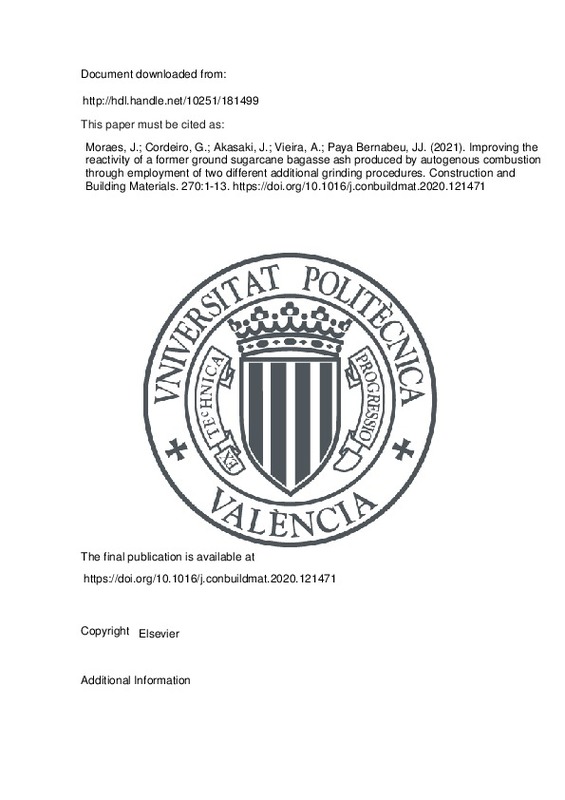JavaScript is disabled for your browser. Some features of this site may not work without it.
Buscar en RiuNet
Listar
Mi cuenta
Estadísticas
Ayuda RiuNet
Admin. UPV
Improving the reactivity of a former ground sugarcane bagasse ash produced by autogenous combustion through employment of two different additional grinding procedures
Mostrar el registro sencillo del ítem
Ficheros en el ítem
| dc.contributor.author | Moraes, J.C.B.
|
es_ES |
| dc.contributor.author | Cordeiro, G.C.
|
es_ES |
| dc.contributor.author | Akasaki, J.L.
|
es_ES |
| dc.contributor.author | Vieira, A.P.
|
es_ES |
| dc.contributor.author | Paya Bernabeu, Jorge Juan
|
es_ES |
| dc.date.accessioned | 2022-03-22T19:02:19Z | |
| dc.date.available | 2022-03-22T19:02:19Z | |
| dc.date.issued | 2021-02-08 | es_ES |
| dc.identifier.issn | 0950-0618 | es_ES |
| dc.identifier.uri | http://hdl.handle.net/10251/181499 | |
| dc.description.abstract | [EN] Studies on reactivity of sugarcane bagasse ash (SCBA), obtained by an autogenous combustion process, with low loss on ignition and three different particle sizes were carried out (SCBA-1, SCBA-2 and SCBA-3). The ashes were characterized by their particle size distribution, chemical composition, X-ray diffraction (XRD), thermogravimetric analysis (TGA) and field emission scanning electron microscopy (FESEM). The ash with lowest particle size was SCBA-3, followed by SCBA-2, which both were finer than SCBA-1. Calcium hydroxide/SCBA blends were assessed by means of loss of electrical conductivity (Lc), TGA and FESEM. Portland cement/SCBA pastes were analyzed through isothermal calorimetry, TGA, FESEM and compressive strength. Results showed that SCBA with lowest particle size (SCBA-3) presented highest reactivity, which resulted in statically significant better compressive strength than that of control paste (with only Portland cement) after 28 days of curing. The improvement on compressive strength by employing SCBA-3 respect to control and SCBA-1 were 17.9 and 14.1%, respectively, after 180 days of curing. | es_ES |
| dc.description.sponsorship | This study was financed in part by the Fundacao Carlos Chagas Filho de Amparo a Pesquisa do Estado do Rio de Janeiro (FAPERJ). | es_ES |
| dc.language | Inglés | es_ES |
| dc.publisher | Elsevier | es_ES |
| dc.relation.ispartof | Construction and Building Materials | es_ES |
| dc.rights | Reconocimiento - No comercial - Sin obra derivada (by-nc-nd) | es_ES |
| dc.subject | Pozzolan characterization | es_ES |
| dc.subject | Calcium hydroxide/pozzolan paste | es_ES |
| dc.subject | Portland cement/pozzolan paste | es_ES |
| dc.subject | Microstructural study | es_ES |
| dc.subject | Compressive strength test | es_ES |
| dc.title | Improving the reactivity of a former ground sugarcane bagasse ash produced by autogenous combustion through employment of two different additional grinding procedures | es_ES |
| dc.type | Artículo | es_ES |
| dc.identifier.doi | 10.1016/j.conbuildmat.2020.121471 | es_ES |
| dc.rights.accessRights | Abierto | es_ES |
| dc.description.bibliographicCitation | Moraes, J.; Cordeiro, G.; Akasaki, J.; Vieira, A.; Paya Bernabeu, JJ. (2021). Improving the reactivity of a former ground sugarcane bagasse ash produced by autogenous combustion through employment of two different additional grinding procedures. Construction and Building Materials. 270:1-13. https://doi.org/10.1016/j.conbuildmat.2020.121471 | es_ES |
| dc.description.accrualMethod | S | es_ES |
| dc.relation.publisherversion | https://doi.org/10.1016/j.conbuildmat.2020.121471 | es_ES |
| dc.description.upvformatpinicio | 1 | es_ES |
| dc.description.upvformatpfin | 13 | es_ES |
| dc.type.version | info:eu-repo/semantics/publishedVersion | es_ES |
| dc.description.volume | 270 | es_ES |
| dc.relation.pasarela | S\431177 | es_ES |
| dc.contributor.funder | Fundação Carlos Chagas Filho de Amparo à Pesquisa do Estado do Rio de Janeiro | es_ES |
| dc.subject.ods | 11.- Conseguir que las ciudades y los asentamientos humanos sean inclusivos, seguros, resilientes y sostenibles | es_ES |







![[Cerrado]](/themes/UPV/images/candado.png)

